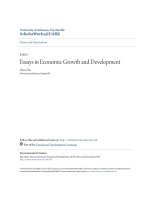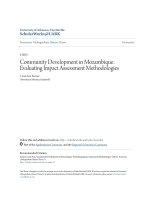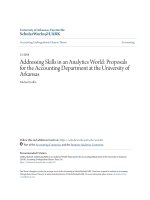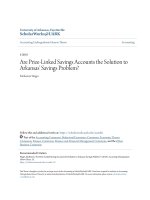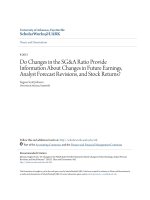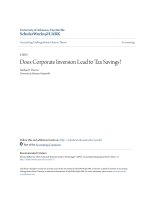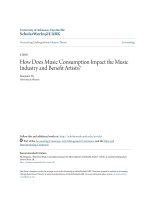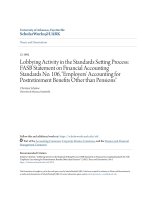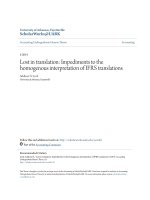Accounting undergraduate Honors theses: Lost in translation - Impediments to the homogenous interpretation of ifrs translations
Bạn đang xem bản rút gọn của tài liệu. Xem và tải ngay bản đầy đủ của tài liệu tại đây (2.08 MB, 31 trang )
University of Arkansas, Fayetteville
ScholarWorks@UARK
Accounting Undergraduate Honors Theses
Accounting
5-2014
Lost in translation: Impediments to the
homogenous interpretation of IFRS translations
Addison N. Scott
University of Arkansas, Fayetteville
Follow this and additional works at: />Part of the Accounting Commons
Recommended Citation
Scott, Addison N., "Lost in translation: Impediments to the homogenous interpretation of IFRS translations" (2014). Accounting
Undergraduate Honors Theses. 10.
/>
This Thesis is brought to you for free and open access by the Accounting at ScholarWorks@UARK. It has been accepted for inclusion in Accounting
Undergraduate Honors Theses by an authorized administrator of ScholarWorks@UARK. For more information, please contact ,
Lost in Translation:
Impediments to the homogenous interpretation of IFRS translations
By:
Addison Nicole Deavers Scott
Advisor: Dr. James Myers
An Honors Thesis in partial fulfillment of the requirements for the degree of Bachelor of
Science in Business Administration in Accounting and Finance and for the degree of
Bachelor of Science in International Business in Economics
Sam M. Walton College of Business
University of Arkansas
Fayetteville, Arkansas
May 10, 2014
Table of Contents
Introduction
Literature Review
Linguistic Analysis
Cultural Analysis
Conclusion and Recommendations
Bibliography
2
5
7
14
22
27
1
Introduction
The past century has been characterized by efforts to make the world more
interconnected. As economies become more integrated, financial information must become
more comparable across borders (Davidson & Chrisman, 1993). In order to satisfy this
growing need, regulators and accounting professionals have pursued the harmonization of
national accounting standards. The effort to develop a transnational set of accounting
standards began with the establishment of the International Accounting Standards Committee
(IASC) in 1973 (FASB, 2013). Now reorganized as the International Accounting Standards
Board (IASB), this transnational organization is responsible for the development of
International Financial Reporting Standards (IFRS). These standards have been adopted in
more than 100 countries and are currently available in 47 languages.
The benefits of IFRS seem intuitive. Before the availability of common international
accounting standards, companies prepared financial statements in accordance with their own
domestic national accounting standards. The differences among these national accounting
standards rendered the comparability of financial information across borders nearly
impossible. IFRS provides a common business language through which users of accounting
information can compare the financial performance of a business in one country with that of a
similar business in another country.
The financial statements for two businesses prepared using the same accounting
standards should be comparable (Doupnik & Richter, 2006). There are reasons to believe that
this is not always the case, even when both businesses use IFRS. One important reason is the
inherent need to translate international accounting standards. While different translations of
IFRS may simply be assumed equivalent, there is strong evidence that translations of
2
accounting standards do not retain their original intent and meaning (Davidson & Chrisman,
1993).
There are many examples of barriers to perfect translation of IFRS. One common
problem is the lack of equivalent accounting concepts in different countries. For example, the
English term “depreciation” is used to describe the systematic and rational allocation of the
cost of tangible assets over the periods benefitted, but a different English term,
“amortization,” is used to describe a similar process used to record allocations of the cost of
intangible assets like goodwill. In Finnish, the term “poisto” is used for both concepts. Thus,
the Finnish language cannot be used to differentiate between the allocation of costs
associated with tangible and intangible assets (Kettunen, 2011). This simple example
illustrates how difficult it can be to translate technical accounting terminology.
Potential problems with translations can also be observed by comparing existing
translations of IFRS texts. For example, while the English term “remote” is used in both IAS
31 and IAS 37 to define thresholds for the disclosure of certain contingent liabilities, the
German version uses “unwahrscheinlich” (in English, “improbable”) in IAS 31 and “äuβerst
gering” (in English, “extremely remote”) in IAS 37 (Tsakumis, Campbell & Doupnik, 2009).
Although English and German accountants use the same accounting standards to guide the
disclosure of contingent liabilities, the translation of the standards appears to encourage
different interpretations for English versus German users. That is, the difference in
terminology used in the German versions of IAS 31 and IAS 37 seems to encourage the use
of different probability thresholds for determining the non-disclosure of the contingent
liabilities referred to in each respective standard while the English version’s consistent use of
the term “remote” seems to imply that approximately the same threshold should be used in
applying both standards. This difference may indicate that English and German accounting
practitioners do not use the same basis for their decisions related to the disclosure of
3
contingent liabilities. Similarly, there may be differences in how English and German
financial statement users interpret contingent liability disclosures. This example clearly
illustrates that inconsistencies in the translations of IFRS may result in significant differences
in their application and interpretation.
Inconsistent application of international accounting standards presents a significant
threat to the comparability of international financial information. When financial information
is prepared in accordance with IFRS, users of that information may assume that the
application of the accounting rules is consistent across countries. In actuality, many
differences in interpretation and application can occur because of the difficulties inherent in
translating the standards from one language to another. This should be a concern for the
international business community.
The problems associated with inconsistent application of translations of IFRS are
difficult to isolate and study. Language is naturally intertwined with elements of culture and
history. Thus, issues with translating technical materials such as accounting standards are
complex (Baskerville & Evans, 2011). This paper seeks to identify some of the factors that
may impede the homogenous interpretation and application of IFRS. Because of the
complexity of the issue, I take a qualitative approach that draws on the disciplines of
linguistics and cultural studies to analyze why translations of international accounting
standards may be misinterpreted.
The structure of this paper is as follows. First, I summarize and review relevant
literature. Next, I analyze specific factors related to misinterpretation using relevant research
from the fields of linguistics and cultural studies. This provides a better understanding of
how translation issues arise and affect the interpretation of IFRS. I then conclude with a
summary of the potential sources of translation problems and provide six recommendations
4
for how to proceed with the development, translation, adoption, and use of IFRS.
Literature Review
As the acceptance of IFRS continues to grow around the world, accounting
researchers have identified translation challenges as a potential roadblock and have called for
greater research on this subject. For example, Nobes (2006, p. 237) explains that “there is a
risk that the process of translation will change or lose meaning from the original version” and
suggests several topics for further research such as the Portuguese translation of the IAS 7
definition of cash and cash equivalents. Zeff (2007) also identifies language as a significant
impediment to the homogenous interpretation of accounting standards and warns that this
problem could inhibit the comparability of accounting information. Tsakumis, Campbell, and
Doupnik (2009, p. 34) identifies translation and culture as “two factors… that could
undermine the rigorous interpretation and application of IFRS” and goes on to further outline
potential problems that arise with translations through specific examples.
Several studies seek to analyze the effects that language has on the interpretation of
uncertainty expressions (Davidson & Chrisman, 1993; Doupnik & Richter, 2003). These
studies measure the interpretation of uncertainty expressions (e.g., probable, certain,
reasonably expected, etc.) by asking subjects from different language groups to assign a
probability to each expression. Results of these experiments indicate that significant
differences in the interpretation of uncertainty expressions exist across different language
groups. This suggests that “perfect translation may not be achievable” (Davidson &
Chrisman, 1992, p. 7).
There is also an emerging body of literature relating to the challenges of translating
accounting standards. Some studies employ a case study approach to analyze problems
associated with the translation of accounting terminology. For example, Evans (2004)
5
surveys the historical development of national accounting subcultures and theories of
linguistics. This serves as the basis for her analysis of three case studies that illustrate
fundamental differences in the way that accounting terms are interpreted by speakers of
different languages. She concludes that “translation is not impossible, but… it is likely to be
incomplete” (Evans, 2004, p. 239. Dalghren and Nilsson (2009) examines Swedish
translations of specific International Accounting Standards, illustrating that existing
translations of standards are often incomplete and not equivalent to the original English
versions.
Other studies employ interview and survey techniques to gather information about
specific problems that IFRS translators face. Through interviews with the translators involved
in the Finnish translation of IFRS, Kettunen (2011) identifies and analyzes key issues with
the translation process, some of which include inherent differences in terminology across
different languages, difficulty in interpreting the original English text, and translators’ lack of
accounting knowledge. Baskerville and Evans (2011) considers a much broader scope,
surveying authors and translators of IFRS accounting textbooks from all European Union
member states and candidate countries. They identify specific challenges that translators face
as well as solutions that translators have used to overcome those challenges. They also
provide relevant policy recommendations that would alleviate some of the difficulties of
translation and limit misinterpretations of IFRS translations. Some of these policy
recommendations include increasing regulators’ awareness of the limitations of translation,
fostering a greater understanding of existing accounting subcultures on the part of translators,
and standardizing IFRS terminology.
Overall, the general consensus among accounting researchers related to the translation
of international accounting standards appears to be that translation is inherently difficult and
can lead to different interpretations and applications of accounting standards. However,
6
there is evidence that effective translation is achievable (Baskerville & Evans, 2011).
Specifically, translators who responded to the survey in Baskerville and Evans (2011) imply
that translation challenges are not entirely insurmountable. They suggest that “[w]here
problems arise, a number of strategies and solutions are adopted to reduce their impact”
(Baskerville & Evans, 2011, p. 57).
Our understanding of translation difficulties and how to overcome them is likely to
grow as the adoption of IFRS spreads. This paper seeks to establish a framework for
considering translation challenges in the development, adoption, and use of international
accounting standards. Understanding the complexity of translation and how to approach it in
the context of international accounting standards is relevant to researchers, policy makers,
accounting professionals, and general users of accounting information.
Linguistic Analysis
The
relevance
of
linguistics
in
the
field
of
accounting
Even before transnational accounting was as tangible as it is today, linguistics was
incorporated into accounting research. Researchers reasoned that accounting is, at its core, a
means of communication. “The language of business” is a common metaphor used to broadly
explain both the purpose and importance of accounting in basic accounting principles courses
and textbooks (Belkaoui, 1978). An interesting question stems from this characterization – is
there a consistent language of accounting among accounting professionals in different parts
of the world or is the “language of accounting” fragmented by region, with non-transferrable
terminology and practices? This question has interesting implications for the feasibility of a
transnational set of accounting standards like IFRS.
Archer and McLeay (1991) attempts to answer this question and concludes that there
are some shared meanings among accounting systems around the world. Basic underlying
7
principles like double entry accounting and accrual accounting seem to be understood and
applied consistently, although more specific terminology and practices, such as the wording
of an audit opinion, can differ dramatically from country to country. This indicates that the
common “language of accounting” has many different accents and dialects, much like many
of the world’s widely spoken languages. This seems to imply that international accounting
standards are attainable, but their development and use will require a great deal of
collaboration with regards to the details of the standards and practices.
Belkaoui (1978) uses the idea of accounting as a language in a somewhat different
manner. He directly applies linguistic theory to the field of accounting in order to understand
how the actual “language of accounting” influences the behavior of its users (i.e., accounting
professors, practitioners, and students). He proposes that accountants’ training and
understanding of accounting concepts enables them to describe particular financial
phenomena that a layperson cannot easily understand and to perform certain tasks more
efficiently than non-accountants. He also hypothesizes that those with an accounting
background are “pre-disposed to certain managerial styles” (Belkaoui, 1978, p. 103). These
assertions stem from the application of what is known in linguistics as the Sapir-Whorf
Hypothesis.
The
Sapir-‐Whorf
Hypothesis:
A
problem
of
perception
The Sapir-Whorf Hypothesis, originally developed by Whorf in 1956, and later
extended by his student Sapir in 1965, essentially proposes that “language is an active
determinant of thought” (Belkaoui, 1978, p. 98). In other words, the language that a person
speaks shapes his or her perception and behavior.
A classic example used to illustrate the Sapir-Whorf hypothesis is that of time. Many
cultures perceive time differently. European-based languages use a standardized, discrete
8
system for determining time, and subsequently, timeliness is paramount in many of these
cultures. However, as Whorf discovered through the development of his hypothesis, not all
languages express time in the discrete manner familiar to many western cultures. By studying
the language and culture of the North American Hopi tribes, Whorf found that their sense of
time was more abstract and continuous than the discrete standard European sense of time
(Van Troyer, 1994). Whorf attributed this perceptual difference to different linguistic
structures available in each respective language for the expression of time.
Another example involves the association of gender with nouns. In German, the word
for bridge, “die Brücke,” is feminine, whereas in Spanish, the same word, “el puente,” is
masculine. Researchers found that German speakers are more likely to describe a bridge as
one might describe a woman, using terms like elegant or beautiful, while Spanish speakers
are more likely to emphasize the masculine qualities of a bridge, such as its strength
(Deutscher, 2010).
While there are many adherents to the Sapir-Whorf Hypothesis, many linguists have
dismissed the hypothesis as superfluous, maintaining that language is not a key determinant
of human perception and behavior. In fact, many empirical studies negate the validity of the
Sapir-Whorf Hypothesis, mainly by illustrating that perceptions and thought processes exist
even in the absence of language. For example, researchers Piaget and Chomsky assert that
“language does not predispose the mind to think in a priori categories; rather, pre-existent
structures at the biological level in the brain are the shapers of language and reality in
general” (Van Troyer, 1994, p. 170). In its strongest form, the Sapir-Whorf Hypothesis posits
that two people who speak different languages will never be able to come to a mutual
understanding. Simple observation of the modern world in which people from different
language speaking groups interact every day proves that this is not the case.
9
Ultimately, the debate over the Sapir-Whorf Hypothesis is similar to the age-old
question of what came first – the chicken or the egg. Regardless of whether it is language or
something else that drives differences in thought and perception, it is evident that “something
basic to the way human beings interpret reality powerfully, ultimately, influences if not
shapes our perception of the world, and by extension, of other cultures” (Van Troyer, 1994, p.
15). The question relevant to international accounting is whether or not those differences are
strong enough to impede the transmission of standard accounting rules and the financial
information that results from their use.
Translation:
Bridging
the
communication
gap
Consider now the means by which communication between individuals from different
language speaking regions is enabled – translation. Professional translators are often the most
avid in proclaiming translation impossible (Joseph, 1998; Baskerville & Evans, 2011).
Practicality, however, encourages us to seek a means of translation that is sufficient and
acceptable.
The purpose of translation is to seek some form of equivalence between the source
text and the translated text. For IFRS, this is of the utmost importance. The IASC Foundation
proposes that “the success of global standards means that it is essential to ensure that IFRSs
remain IFRSs in any country and in any language that they are translated into” (Dahlgren &
Nilsson, 2009, p. 6). If the translations of IFRS are not equivalent, then the entire purpose of
international standards has been defeated. If translators generally agree that perfect
translation is impossible, what kind of equivalence is attainable through translation?
Pym (2007, p. 272) proposes that equivalence is attained when “the translation [has]
the same value as (some aspect of) the source text.” Translators must decide which aspects of
the source text to retain in the translation. The body of literature on translation theory posits
10
that there are two general forms of equivalence – formal and dynamic. Formal equivalence
refers to strict, word-for-word translation of the source text so that the structure and
terminology are as close to the original text as possible. This kind of translation typically
requires more effort on the part of the reader in order to understand the meaning of the
translation. Alternatively, dynamic equivalence may require the translator to stray from the
original structure and terminology of the source text in order to convey the sense and
meaning of the source text more clearly in the translation. This type of equivalence typically
requires more effort on the part of the translator in order to make the reader of the translation
more comfortable with the text. The type of text being translated may very well dictate the
type of translation approach used.
The IASB requires the word-for-word formal equivalence approach for translations of
IFRS (Kettenun, 2011). As illustrated by the examples provided in this paper, perfect
equivalents are not always readily available in the target language. Thus, the IASB’s
preference for formal equivalence may limit the understandability of IFRS translations.
Accounting researchers have attempted to understand how translators of international
accounting information and standards approach these problems of non-equivalence. Archer
and McLeay (1991) identify two types of “coping strategies” employed in these situations –
reduction and achievement strategies. Reduction strategies involve avoidance of translation
when challenges arise. These strategies may involve referencing the source text instead of
attempting translation or retaining non-translatable words or phrases in the original language.
If there is a word or phrase that does not translate easily, the translator employing this
strategy may even omit the section entirely from the translation.
Alternatively, achievement strategies attempt to solve translation challenges through
various means. This kind of strategy may involve adding a description of an unfamiliar term
in order to make it more comprehendible to the reader or creating a new term in the target
11
language to refer to the unfamiliar term or phrase from the source text. More recent research
has confirmed that these strategies are commonly used, specifically among the translators of
IFRS (Kettenun, 2011; Baskerville & Evans, 2011).
Baskerville and Evans (2011) investigates the preferred “coping strategy” by language
group, which provides considerable insight into how various IFRS translations may vary.
The results are shown in Figure 1 below. This research suggests that Slavic translators are the
most likely to use avoidance strategies and request clarification from the IASB.
Alternatively, Scandinavian and Romance family language translators appear to prefer
achievement strategies, in particular, paraphrasing and adding descriptions of unfamiliar
terms to the translation.
Figure 1: Solution preferences of the different language groups.
Source: Baskerville, R. & Evans, L. (2011). The darkening glass: Issues for translation of
IFRS. Edinburgh: The Institute of Chartered Accountants of Scotland. Figure 13.
These findings have important implications for users of translations of IFRS. Since
Slavic translators frequently use avoidance strategies that adhere to a formal equivalence
12
approach, the users of the Slavic translations will likely have to exert more effort when
reading the standards. For example, they may have to consult original texts in order to
understand the meaning of a term or phrase that is unfamiliar to Slavic speakers.
Alternatively, Scandinavian and Romantic language family IFRS translations are more likely
to include in-text definitions of unfamiliar terms and phrases which would require users of
the translation to consult the original source text less frequently, if at all. This may imply that
Slavic users of IFRS are more familiar, and thus more closely aligned, with the original
English version than Scandinavian or Romantic language family users. Paraphrasing and intext explanations may also imply that Scandinavian and Romantic family language translators
are more likely to incorporate their own interpretations of the standards into their translations
than are Slavic translators. This phenomenon would naturally result in inconsistent
interpretations of IFRS across users of different translations.
The challenges that translators face extend beyond just the scarcity of equivalent
terms and phrases. Other problems cited by IFRS translators include the complexity of the
original English standards, translators’ lack of accounting knowledge, and underlying cultural
differences (Kettenun, 2011; Baskerville & Evans, 2011). The IASB attempts to combat
some of these challenges through its systematic translation process. Professional translators
who collaborate with an IASB review committee complete most IFRS translations. The
purpose of the review committee is to provide guidance and oversight on how the standards
should be interpreted in the new language. This should compensate for the professional
translators’ lack of accounting knowledge and help clarify technical accounting jargon found
in the standards. However, some European language translations of IFRS were facilitated by
the translation function of the European Union without the consultation of an IASB review
committee (Dahlgren & Nilsson, 2009). Thus, there is room for improvement in the IFRS
translation process.
13
Despite all of the challenges related to language and translation, there appears to be a
general consensus that adequate translation of IFRS is feasible (Baskerville & Evans, 2011).
This is encouraging for the future of IFRS; however, challenges of translation should not be
overlooked or dismissed as insignificant. Standard setters and accounting practitioners need
to understand the limitations of language and translation.
Cultural Analysis
The
existence
of
international
accounting
cultures
It can be inferred from the discussion thus far that differences in language and
perception among IFRS adopting countries may impede the homogenous interpretation and
application of IFRS. These differences may be explained at least in part by existing national
accounting sub-cultures.
There have been several attempts to categorize international trends in accounting
values and practices (Nobes & Parker, 2008). One of the first researchers to attempt such a
categorization was Gerhard Mueller, who identified four types of accounting approaches – a
macroeconomic approach, a microeconomic approach, accounting as an independent
discipline, and uniform accounting (Nobes & Parker, 2008). The economies of countries
classified as exhibiting a macroeconomic approach are significantly influenced by the state.
As such, accounting rules and practices in these countries are typically influenced by the
government’s economic policies. Alternatively, the economies of countries with a
microeconomic approach are primarily driven by the private sector. Accounting rules and
practices in these countries are flexible and more likely to be influenced by the needs of
individual businesses. Countries that approach accounting as an independent discipline
typically have standard setting bodies that are independent of the government and the private
sector. Finally, countries that exhibit uniform accounting have accounting systems that
14
are typically developed and controlled by the government either through strict tax accounting
requirements or government accounting standard setting bodies.
Nobes (1996) builds on Mueller’s classifications. He uses 9 separate factors,
including, for example, the types of users of accounting information and the relative
importance of tax rules. Using these factors, Nobes judgmentally classifies 14 Western
developed countries into the hierarchy shown in Figure 2 below. The hierarchy appears to
represent a more detailed explanation of Mueller’s four-group classification system;
Mueller’s groups are evident at the sub-class and family levels of Nobes’ hierarchy. Nobes
adds a distinction between the UK influenced and US influenced systems of accounting that
fall into Mueller’s more generalized “accounting as an independent discipline” classification.
He also differentiates between “uniform accounting systems” based on the different sources
of accounting rules imposed by the state. Both Mueller and Nobes’ classifications are
combined in Figure 2 on page 16.
15
Figure 2: Combination of Nobes’ hierarchical classification of accounting systems and
Mueller’s four-group classification of accounting systems
Micro-economic
Approach
Accounting as an
Independent Discipline
Uniform Accounting
Macro-Economic
Approach
Adapted from: Nobes, C. & Parker, R. (2008). Comparative International Accounting. (10
ed., pp. 74-93). Harlow, England: Pearson Education Limited. Figure 3.3.
There have been many other attempts to construct international accounting system
classifications based on a variety of factors (e.g., economic drivers, regulatory style, culture,
etc.) (Nobes & Parker, 2008). The development of these classifications is evidence of
differences across accounting systems in different countries. Although there is some
disagreement among researchers about the best way to classify international accounting
systems, there appears to be a consensus that there exist identifiable patterns of accounting
practice that differ by country (Gray 1988). The divergence of accounting systems across
regions can likely be explained both by historical and cultural trends.
History has played a large role in the development of legal systems and business
environments around the world. Consequently, domestic accounting systems have developed
differently to suit differing needs of various legal environments and business communities.
Most legal systems in the developed world are based on either Common Law or Roman
16
Law. Common Law was developed during the Middle Ages in England, in part due to the
Norman Invasion of 1099 (Evans, 2004). Unfamiliar with the local customs and language,
Norman invaders from continental France found it difficult to impose their culture and
traditions on their conquered English subjects; thus, they developed a feudal system in which
the central court imposed case law rather than codified law. This legal system was pragmatic
and focused on prescribing solutions to individual problems and disputes as they arose
(Evans, 2004). English Common Law was imposed in the English colonies, and it is still the
prevailing legal system in many countries, including the United States.
Roman Law was developed first in the Roman Empire and was later revived in the
major cultural centers of continental Europe during the Renaissance (Evans, 2004). The
revival of Roman Law was largely academic and appealed to the educated by employing
logic to develop a universal justice system that could be applied anywhere. As such, Roman
Law was much more theoretical and required codification in order to be put into practice
(Evans, 2004). Roman Law still provides the foundation for the legal systems of many
Continental European countries like Germany and France. The differences across the legal
systems of these countries are largely attributable to differences in the style and development
of each country’s codification of Roman Law (Evans, 2004).
Since accounting culture stems in part from the legal environment of a particular
country, understanding the history of these different legal systems can aid in our
understanding of the differences across accounting systems. The Anglo-Saxon Common Law
countries tend to be grouped together in international accounting system classifications. The
traits common to these countries’ accounting systems are well suited to a legal environment
based on Common Law. These accounting systems are generally pragmatic and set up to
solve problems on a case-by-case basis through an independent standard setting body such as
the Financial Accounting Standards Board (FASB) in the United States. Alternatively,
17
the Roman Law-based, Continental European countries are generally grouped together in
international accounting classifications based on qualities that are characteristic of Roman
Law. Accounting standards in these countries are typically rules-based. Similarly, these
countries’ codified legal systems consist of a set of rules based on the universal notions of
justice found in Roman Law.
Understanding
the
impact
of
culture
on
accounting
practices
Many researchers have sought to use national and regional culture to explain the
phenomena of different accounting sub-cultures. Hofstede (1983) develops a framework for
understanding cultural differences that consists of four cultural dimensions – power distance,
uncertainty avoidance, individualism versus collectivism, and masculinity versus femininity.
The dimension of power distance explains how a society perceives authority.
Countries with high power distance are typically comfortable with hierarchical organizational
structures in which those with power make important decisions without consulting those
below them in the hierarchy. Low power distance countries are typically more critical of
power and prefer a less rigid and less hierarchical organizational structure in which leaders
actively incorporate the concerns and advice of those at different levels within the
organization.
Uncertainty avoidance describes how comfortable a society is with ambiguity.
Countries with high uncertainty avoidance value security and are less likely to pursue risktaking behaviors than are countries with low uncertainty avoidance.
Countries that are characterized by individualism are focused on the success of
individual persons and private enterprise. Alternatively, collectivist societies are more
focused on the well being of the community and how individuals fit into society as a whole.
Finally, masculinity denotes a society’s appreciation of traditionally masculine traits
18
like strength, recognition, and power, while femininity denotes a society’s appreciation of
traditionally feminine traits like nurturance, responsibility, and collaboration. More masculine
societies typically encourage and award personal achievement and success. More feminine
societies typically value interdependence and quality of life more than personal achievement
and power.
Gray (1988) analyzes how Hofstede’s framework can be applied to basic attitudes in
accounting. He identifies four accounting values that can be linked to the four cultural
dimensions proposed by Hofstede – professionalism versus statutory control, uniformity
versus flexibility, conservatism versus optimism, and secrecy versus transparency.
Professionalism versus statutory control, which measures preference for professional
judgment in financial reporting, and uniformity versus flexibility, which measures flexibility
and options available within accounting standards, are most closely linked to Hofstede’s
individualism and uncertainty avoidance dimensions. Conservatism versus optimism, which
measures preference for conservative measurements in financial reporting, is most closely
related to uncertainty avoidance and, to a lesser extent, masculinity and individualism.
Finally, secrecy versus transparency, which measures the extent of disclosure, is most closely
linked to uncertainty avoidance, power distance, and individualism. This leads to four
theoretical hypotheses about the relationships between Gray’s accounting values and
Hofstede’s cultural dimensions. Gray (1988) adapts Hofstede’s analyses to provide a visual
representation of accounting values by country on two separate planes. The first, provided in
Figure 3 on page 20, describes authority and enforcement values with axes for
professionalism versus statutory control and flexibility versus uniformity. The second,
provided in Figure 4 on page 20, describes measurement and disclosure with axes for secrecy
versus transparency and conservatism versus optimism.
19
Figure 3: Accounting Systems: Authority and Enforcement
Source: Gray, S. (1988). Towards a theory of cultural influence on the development of
accounting systems internationally. Abacus, 24(1), 1-15. Figure 3.
Figure 4: Accounting Systems: Measurement and Disclosure
Source:
Gray, S. (1988). Towards a theory of cultural influence on the development of
accounting systems internationally. Abacus, 24(1), 1-15. Figure 4.
20
The classifications of these countries in Gray’s framework appear to compliment the
environmental and historical classifications of accounting systems. For example, in Figure 3,
Anglo countries (i.e., the UK, US, etc.) are positioned in the far left corner of the flexibility,
professionalism plane. This high placement on the professionalism scale is consistent with
Mueller’s classification of Anglo countries as belonging to the “accounting as an independent
discipline group” in which professional judgment is highly regarded. Likewise, the high
placement on the flexibility scale is consistent with Anglo countries’ historical Common Law
influence, which emphasizes practicality and problem solving on a case-by-case basis.
This analysis adds to our understanding of international accounting cultures,
demonstrating that it is important to understand differences across national accounting subcultures in order to successfully implement international accounting standards like IFRS.
Evidence
and
implications
of
cultural
influence
on
accounting
practices
Much of the discussion thus far has been largely theoretical. Therefore, the question
remains – does culture actually impact the way that international standards are understood
and applied? Several studies subsequent to Gray (1988) substantiate Gray’s hypotheses
(Tsakumis, 2007). For example, after surveying the relevant research to date, Fechner and
Kilgore (1994) analytically determines that Gray’s hypotheses appear reasonable and
concludes that there is a relationship between culture and accounting practice. Tsakumis
(2007) also provides support for Gray’s hypotheses and cites a plethora of other supportive
tests. These results imply that cultural differences across countries give rise to different
perceptions of basic accounting principles. The existence of these differences may make the
implementation of uniform accounting standards across different accounting sub-cultures
difficult.
Belkaoui and Picur (1991) examines the cognitive impact of culture on the
21
development of accounting values and practices. Using survey data from the “Big Six”
accounting firms in the US, Great Britain, and Canada, Belkaoui and Picur (1991)
demonstrates that national culture influences perception of accounting concepts and
principles. The researchers note that their results may be indicative of “communication
problems that may arise in the perception of accounting concepts as a result of differences in
the cognition or systems of knowledge of each particular culture” (Belkaoui & Picur, 1991, p.
125). In addition to potential communication problems, these findings suggest that IFRS
might not be interpreted and applied homogenously by all users. Importantly, perceptual
differences were found across three Anglophone countries. Differences are likely to be
exaggerated between countries that are less linguistically and culturally similar.
Bagranoff, Houghton, and Hronsky (1994) also provides evidence that cultural
differences strongly impact accounting practices. Specifically, this study finds that slight
cultural differences between American and Australian accountants result in “significant
differences in the types of decisions” made relating to classification of items as
“extraordinary” (Bagranoff, Houghton, & Hronsky, 1994, p. 50). If culture does in fact
influence our decision-making processes, this provides another hurdle for the effective use of
IFRS. In order to achieve comparability, accountants using IFRS should determine the
classification of financial statement items in approximately the same way. If accountants in
one country are more likely to recognize items as extraordinary than are accountants in
another country, this could result in major differences among financial statements prepared in
accordance with IFRS, thus undermining the goal of comparability.
One way to address these potential problems may involve some level of “re-learning”
on the part of IFRS accounting practitioners. Whittington (2008) suggests that “one way in
which the IASB can attempt to overcome… cross-constituency variation is through the
conceptual framework” (Whittington, 2008, p. 497). Ultimately this framework
22
establishes the principles underlying IFRS. The development of this framework is rightly a
contentious topic due to the fact that its development is contingent upon the collaboration and
consensus of standard setters from many different accounting sub-cultures. The acceptance of
this framework is essential to the success of IFRS. If adopters of IFRS can embrace the same
basic principles, progress can be made toward the homogenous understanding and application
of more complicated rules and standards.
Conclusion and Recommendations
This paper identifies some of the problems that may hinder the homogenous
interpretation and application of IFRS and thus impede the comparability of financial
statements prepared in accordance with IFRS. These problems stem from a variety of sources
including language barriers, technical translation challenges, and underlying cultural and
historical differences. As acceptance of IFRS continues to spread, it is important to address
the challenges that the translation of IFRS poses. The following six recommendations would
greatly reduce the challenges of translation and aid the successful adoption of IFRS.
1. Further
research
The IFRS standards that are subject to the highest risk of difference in interpretation
and application among practitioners are those that require professional judgment.
Professional judgment is susceptible to cultural biases which may influence the way
that accountants make decisions about how to classify “extraordinary items,”
determine the likelihood of a contingency, or assess the impairment of intangible
assets. Further research and empirical analyses are required to determine the extent to
which the problems associated with the translation of IFRS materially impact the
application of accounting rules. In addition, further research is needed to determine
whether inconsistent application of accounting information would affect the value
23
